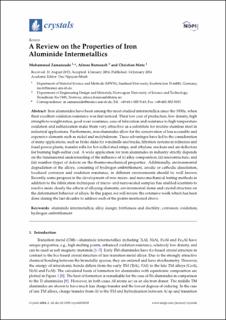| dc.description.abstract | Iron aluminides have been among the most studied intermetallics since the 1930s, when their excellent oxidation resistance was first noticed. Their low cost of production, low density, high strength-to-weight ratios, good wear resistance, ease of fabrication and resistance to high temperature oxidation and sulfurization make them very attractive as a substitute for routine stainless steel in industrial applications. Furthermore, iron aluminides allow for the conservation of less accessible and expensive elements such as nickel and molybdenum. These advantages have led to the consideration of many applications, such as brake disks for windmills and trucks, filtration systems in refineries and fossil power plants, transfer rolls for hot-rolled steel strips, and ethylene crackers and air deflectors for burning high-sulfur coal. A wide application for iron aluminides in industry strictly depends on the fundamental understanding of the influence of (i) alloy composition; (ii) microstructure; and (iii) number (type) of defects on the thermo-mechanical properties. Additionally, environmental degradation of the alloys, consisting of hydrogen embrittlement, anodic or cathodic dissolution, localized corrosion and oxidation resistance, in different environments should be well known. Recently, some progress in the development of new micro- and nano-mechanical testing methods in addition to the fabrication techniques of micro- and nano-scaled samples has enabled scientists to resolve more clearly the effects of alloying elements, environmental items and crystal structure on the deformation behavior of alloys. In this paper, we will review the extensive work which has been done during the last decades to address each of the points mentioned above. | en_US |

